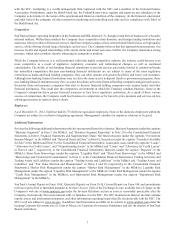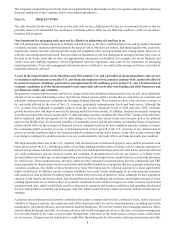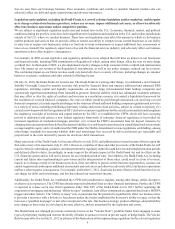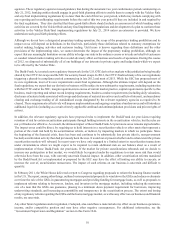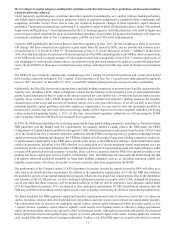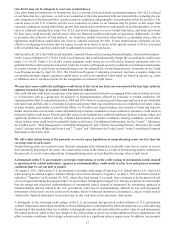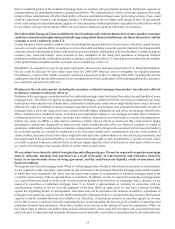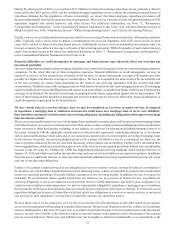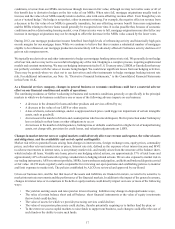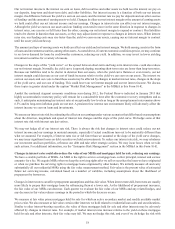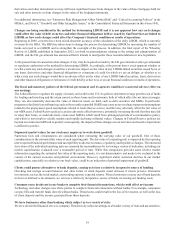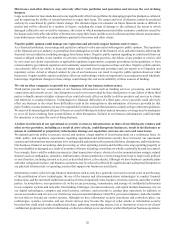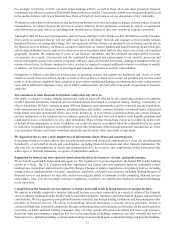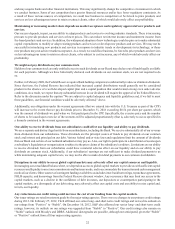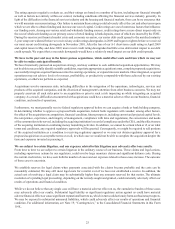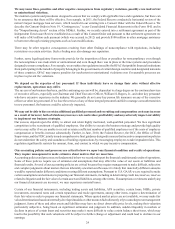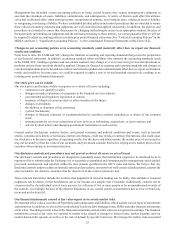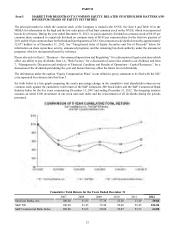SunTrust 2012 Annual Report Download - page 33
Download and view the complete annual report
Please find page 33 of the 2012 SunTrust annual report below. You can navigate through the pages in the report by either clicking on the pages listed below, or by using the keyword search tool below to find specific information within the annual report.17
conditions, revenue from our MSRs can increase through increases in fair value, although we may not realize some or all of
this benefit due to derivative hedges on the fair value of our MSRs. When rates fall, mortgage originations usually tend to
increase and the value of our MSRs usually tends to decline, also with some offsetting revenue effect. Even though they can
act as a “natural hedge,” the hedge is not perfect, either in amount or timing. For example, the negative effect on revenue from
a decrease in the fair value of our MSRs is generally immediate, but any offsetting revenue benefit from more originations
and the MSRs relating to the new loans would generally be recognized over time. It is also possible that, because of economic
conditions and/or a deteriorating housing market, even if interest rates were to fall, mortgage originations may also fall or any
increase in mortgage originations may not be enough to offset the decrease in the MSRs value caused by the lower rates.
During 2012, our mortgage production income benefited from high levels of refinancing activity and historically high gain
on sale margins for our mortgage loans. While we continue to believe that there remains a substantial number of mortgages
eligible to be refinanced, our mortgage production income likely will be adversely affected if refinance activity declines or if
gain on sale margins narrow.
We typically use derivatives and other instruments to hedge our mortgage banking interest rate risk. We generally do not hedge
all of our risk, and we may not be successful in hedging any of the risk. Hedging is a complex process, requiring sophisticated
models and constant monitoring. We may use hedging instruments tied to U.S. Treasury rates, LIBOR or Eurodollars that may
not perfectly correlate with the value or income being hedged. We could incur significant losses from our hedging activities.
There may be periods where we elect not to use derivatives and other instruments to hedge mortgage banking interest rate
risk. For additional information, see Note 16, “Derivative Financial Instruments,” to the Consolidated Financial Statements
in this Form 10-K.
As a financial services company, changes in general business or economic conditions could have a material adverse
effect on our financial condition and results of operations.
The continuing weakness or further weakening in business and economic conditions generally or specifically in the principal
markets in which we do business could have one or more of the following adverse impacts on our business:
• A decrease in the demand for loans and other products and services offered by us;
• A decrease in the value of our LHFS or other assets;
• A loss of clients, reduced earnings, and/or a suppressed stock price could trigger an impairment of certain intangible
assets, such as goodwill;
• An increase in the number of clients and counterparties who become delinquent, file for protection under bankruptcy
laws or default on their loans or other obligations to us; or
• An increase in the number of delinquencies, bankruptcies or defaults could result in a higher level of nonperforming
assets, net charge-offs, provision for credit losses, and valuation adjustments on LHFS.
Changes in market interest rates or capital markets could adversely affect our revenue and expense, the value of assets
and obligations, and the availability and cost of capital and liquidity.
Market risk refers to potential losses arising from changes in interest rates, foreign exchange rates, equity prices, commodity
prices, and other relevant market rates or prices. Interest rate risk, defined as the exposure of net interest income and MVE
to adverse movements in interest rates, is our primary market risk, and mainly arises from the structure of the balance sheet,
which includes all loans. Variable rate loans, prior to any hedging related actions, are approximately 57% of total loans and
approximately 43% of total loans after giving consideration to hedging related actions. We are also exposed to market risk in
our trading instruments, AFS investment portfolio, MSRs, loan warehouse and pipeline, and debt and brokered deposits carried
at fair value. ALCO meets regularly and is responsible for reviewing our open positions and establishing policies to monitor
and limit exposure to market risk. The policies established by ALCO are reviewed and approved by our Board.
Given our business mix, and the fact that most of the assets and liabilities are financial in nature, we tend to be sensitive to
market interest rate movements and the performance of the financial markets. In addition to the impact of the general economy,
changes in interest rates or in valuations in the debt or equity markets could directly impact us in one or more of the following
ways:
• The yield on earning assets and rates paid on interest-bearing liabilities may change in disproportionate ways;
• The value of certain balance sheet and off-balance sheet financial instruments or the value of equity investments
that we hold could decline;
• The value of assets for which we provide processing services could decline;
• The value of our pension plan assets could decline, thereby potentially requiring us to further fund the plan; or
• To the extent we access capital markets to raise funds to support our business, such changes could affect the cost of
such funds or the ability to raise such funds.


